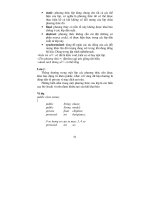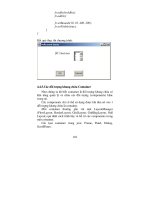Java Messaging Services
Bạn đang xem bản rút gọn của tài liệu. Xem và tải ngay bản đầy đủ của tài liệu tại đây (1.16 MB, 33 trang )
Java Messaging Services
I
f you have had experience of messaging middleware, like MQSeries from IBM, you will
already understand the concept of messaging. There are many different forms of messaging—
some use mailboxes (where a message must be placed in the mailbox and then retrieved from
it), and some use direct connections.
Messaging can be broken down into two models: synchronous and asynchronous.
Synchronous messaging requires that a response be received from the message recipient to
say that the message was received in good order. Asynchronous messaging requires no such
confirmation and for this reason can be less reliable. Asynchronous messaging is highly analo-
gous to sending a letter. (When we cover SOAP, we will expand on this analogy.)
Java Message Service (JMS) is asynchronous, but it is highly reliable. This reliability can be
“turned down” if you have an application that doesn’t worry about missed or duplicate mes-
sages. JMS is also said to be loosely coupled; that is, it does not communicate directly with the
other party.
■
Note
The BAPI (RFC) call discussed in Lesson 20 was a good example of a tightly coupled system.
JMS is simply a collection of classes (APIs) that developers can use to send and receive
messages. The standard format for these messages is XML—specifically the Simple Object
Access Protocol (SOAP). This protocol is equally important in the SAP world, since Exchange
Infrastructure makes use of JMS and uses SOAP/XML as its communications protocol.
Although JMS can adequately support both point to point messaging and publish and
subscribe messaging, we will only be covering the former in this lesson.
THE TWO CONNECTION METHODOLOGIES
There are two ways to design your message connection. The first is to use a point to point connection.
Essentially this relays a message from point A to point B and vice versa. This is still one of the most common
implementations, but increasingly people are using pub/sub or publish/subscribe. In this case, the message
is sent to a topic, and it can be used or “consumed” by many clients. In this lesson, we will be examining a
point to point scenario.
165
LESSON 24
■ ■ ■
6250CH24.qxd 2/22/06 5:07 PM Page 165
It is important to keep in mind that JMS and SOAP are completely separate technologies. I
am discussing them together here for the simple reason that we do not send messages using
JMS in SAP without first putting the messages into a SOAP format. JMS does not require that
your messages be in SOAP format, but it does make life easier. Conversely, SOAP (or SOAP
with Attachments API for Java—SAAJ—from a Java perspective) works with countless other
technologies outside the JMS context.
JMS Scenarios
Common messaging scenarios include sending intra-organizational messages and B2B (busi-
ness-to-business) messages. Let’s take a look at an example of a simple intra-organizational
message, also called application-to-application (A2A) messages.
Let’s assume we have an order entry application that allows for the creation of a sales
order. Once the sales order has been created, we may want to send this information to a pro-
duction system to produce the stock for the order. This is not a contrived example—many
enterprises have separate systems for ordering and production. The production system will
then feed this information into its demand planning, and it may send other messages to other
systems, like accounting, using the same mechanism.
A common trend these days is to outsource aspects of the business that are not “core”
to the enterprise. Let’s say this company—Acme Beans—makes beans. It does not consider
distribution of its product to be “core” to the company. It uses another company—ABC
Logistics—to handle storage and distribution of the product.
Once a customer places an order, this must be communicated to the distributor, and the
distributor must tell Acme Beans that the delivery has taken place. Figure 24-1 shows this in
schematic form. This can be accomplished using JMS to send these documents as messages,
providing a fast and reliable way of communicating across businesses.
Figure 24-1. A simple B2B process
These days it is rare that JMS works by itself. It can, of course, but it is more efficient and
more robust to have middleware between the two parties.
LESSON 24
■
JAVA MESSAGING SERVICES166
6250CH24.qxd 2/22/06 5:07 PM Page 166
SOAP
Earlier in this lesson, I compared asynchronous communication to sending a letter. As we
delve into SOAP, we can take this letter analogy a little further. Have a look at the diagram in
Figure 24-2 to get an idea of this.
Figure 24-2. The SOAP layer
Think of Russian dolls when you look at this figure. The body and header live inside the
envelope, the envelope lives inside the part, and the part is wrapped inside the message. The
actual data in the message—an order, for example—will be contained in the body. The header,
which is optional, will contain routing, level of service, intermediate destinations, and sending
and receiving party information. The envelope will contain information about message
encoding—this is a very powerful aspect of SOAP, as it allows us to create our own data types.
JAXM
Now that we have a basic understanding of the SOAP message, let’s look at how we would code
up a very simple example. Our example program will send a request for stock to another party
and receive the response.
Since we are using Java to process our XML/SOAP messages, we should use Java API for
XML Messaging (JAXM). JAXM implements SOAP with Attachments API for Java (SAAJ). You
can download JAXM and SAAJ as separate APIs, or you can point your CLASSPATH to the JAR file
for your J2EE implementation.
The packages we are primarily interested in are these:
javax.xml.soap
javax.xml.messaging
LESSON 24
■
JAVA MESSAGING SERVICES 167
6250CH24.qxd 2/22/06 5:07 PM Page 167
The first thing we need to do is build the connection. This must be done within a try . . .
catch block.
try
{
// Create the connection first
SOAPConnectionFactory scf = new SOAPConnectionFactory.newInstance();
SOAPConnection con = scf.createConnection();
Now we need to create the message in a very similar way. Notice the method we use to
create a new instance:
// Now create the message
MessageFactory mf = new MessageFactory.newInstance();
SOAPMessage msg = mf.createMessage();
It really is that easy! Now all we need to do is populate our message. First, let’s build all the
message pieces. Refer to the diagram in Figure 24-2 as we go along.
// Build the message pieces
SOAPPart part = msg.getSOAPPart();
SOAPEnvelope envelope = part.getEnvelope();
SOAPBody body = envelope.getBody();
In the next snippet of code, you will see the message being built. Obviously in real life we
would not hard-code strings in this way:
// Create the SOAP request
Name bodyName = envelope.createName("request-stock", "Request
Stock","");
SOAPBodyElement requestStock = body.addBodyElement(bodyName);
Name requestName = envelope.createName("request");
SOAPBodyElement request = requestStock.addChildElement(requestName);
request.addTextNode("Send Stock List");
msg.saveChanges();
Now we have our message. Next we need to create our target, or endpoint, and send the
message through. Again, there are no surprises here. It isn’t really necessary to save the
changes using the saveChanges method, but we’ll call it for safety’s sake.
// Create Endpoint and send the request
URL endpoint = new URL("http://localhost:8080/stock/servlet/stocklist");
SOAPMessage response = con.call(msg, endpoint);
con.close();
// Quick and easy way to drill down to the body
SOAPBody responseBody = response.getSOAPBody();
// Old code
// SOAPBody responseBody = response.getSOAPPart().getEnvelope().getBody();
LESSON 24
■
JAVA MESSAGING SERVICES168
6250CH24.qxd 2/22/06 5:07 PM Page 168
■
Note
In the latest version of JAXM, we don’t have to go through the part and envelope to get to the body
and examine the response.
It may be confusing in the first part of the snippet to see a response when we are trying to
send the message, but let’s look at each line. The URL sets up the endpoint. You can probably
see here that we are calling a servlet to send a response. In the next line, we run the call
method, sending the message and the destination as arguments.
We now wait until a response has been sent. Once we have the response, we would
normally iterate through the elements, examining the data.
Other Considerations When Using JMS
Although the previous somewhat trivial example will work without any problems, many enter-
prises insist on a certain level of guarantee that messages are transmitted successfully. For
this reason, we normally employ middleware to manage our connections in a more profes-
sional way.
If you are working in an IBM WebSphere environment, for example, you would probably
use MQSeries to manage your messaging. In this case, you would use the APIs provided by
IBM to build your connection.
The same argument applies to a SAP Exchange Infrastructure environment. For the
point to point model, you would use the javax.jms.QueueSender class to send messages to a
queue, and the javax.jms.QueueReceiver class to retrieve messages. The publish/subscribe
model also has its own SAP-specific APIs. These are javax.jms.Topic to set up a topic,
javax.jms.TopicPublisher to send to a topic, and javax.jms.TopicSubscriber to consume
a message.
In short, when working in specific environments, you should review the APIs first.
In the next lesson, we will look at messaging again, in something called a message-driven
bean. This is all part of the wonderful world of Enterprise JavaBeans.
LESSON 24
■
JAVA MESSAGING SERVICES 169
6250CH24.qxd 2/22/06 5:07 PM Page 169
6250CH24.qxd 2/22/06 5:07 PM Page 170
Enterprise JavaBeans 3.0
O
ne of the biggest complaints in the Java community recently has been the increasing
complexity of the J2EE environment. This has been especially valid in the area of Enterprise
JavaBeans (EJB). EJB was not easy to use in the 1.1 environment, and although version 2.0
introduced some additional functionality—like message-driven beans—it did little towards
reducing the complexity of developing with EJB.
Well, I have good news, and I have bad news. The good news is that the latest release of
EJB (version 3.0) has made a good attempt at reducing this complexity. The bad news is that I
will go through the older specification first. I do this so that you can see how EJB has devel-
oped. This, I hope, will make you a better practitioner of EJB.
Working with EJB 2.x
EJB allows for a distributed implementation of a Java application. The implementation, or
bean, is wrapped inside a container, which manages the security, the transactions, and the
persistence of each operation. A container can be likened to a web server running a servlet.
Many beans can run in one container.
There are basically three different types of beans: the session bean, the entity bean, and
the message-driven bean.
The Session Bean
It is useful to think of a session bean as representing a client session. Although this is not
strictly true, it’s a good enough analogy. The session bean works for the client, allowing the
client to run its methods. It hides the complexity from the client.
A session bean “belongs” to one client. When the client terminates, the session bean is
no longer associated with that client.
There are some rules for building a session bean:
• The bean must implement the SessionBean interface
• The class must be public
• The class cannot be abstract or final
• The class must implement at least one ejbCreate method
• The class should implement the business methods (more on this later)
171
LESSON 25
■ ■ ■
6250CH25.qxd 2/23/06 10:26 AM Page 171
• The class should contain a public constructor with no parameters
• It must not define the finalize method
Session beans themselves can be of two types: stateless and stateful.
Stateless Beans
Stateless beans receive messages from the client and send a returning messages. In other
words, the bean does not stay connected to the client. Once the method call is complete, the
connection between the client and the session bean is broken.
The benefits of using stateless beans are that they are held in memory, not on disk, and as
such they have a performance benefit over stateful beans. They can also service many clients
(though only one at a time) and they can also implement a web service.
Stateful Beans
In contrast to the stateless bean, the stateful bean retains a connection to the client. This is
more like making a telephone call than sending a message. Because of this, the state that
exists between the client and the bean is called the conversational state.
You would use a stateful session bean if you need to retain information about the client
from one invocation to the next. It is also useful to act as a façade controller to manage entity
beans.
The Entity Bean
The entity bean represents a business object. This is held in a persistent state (on storage
somewhere). A good example of an entity bean would be the object for a sales order. This
would typically read and write sales order information to the database.
If the bean itself is writing to and reading from the database, it is called bean-managed
persistence. If the container manages the persistence, then the entity bean does not need to
code for it—the EJB container itself makes the calls to the database. This is called container-
managed persistence.
The entity bean must use some code called EJB Query Language (QL) to tell the container
what to read or write from the database. This is actually a nice way of doing things, since the
entity bean does not need to worry about the underlying database, database drivers, and
the like.
Here is a snippet showing some EJB QL:
SELECT OBJECT(p)
FROM Player p
WHERE p.teams IS NOT EMPTY
Many clients can use an entity bean, since many clients may want to update the same
data. This is managed by working within transactions. The transaction management is
handled by the EJB container.
Each entity bean must have a primary key, just as each database record needs a key—it
needs this to be uniquely identified. Also, like database records, entity beans can have rela-
tionships. For example, our sales order entity bean would have a relationship to the customer
entity bean.
LESSON 25
■
ENTERPRISE JAVABEANS 3.0172
6250CH25.qxd 2/23/06 10:26 AM Page 172
Obviously, if you have written your own database code in the bean, you would have to
manage your own relationships. However, if you have used EJB QL to determine the relation-
ships, the container will manage them.
If you have chosen to let the EJB container manage your relationships, you must use the
Abstract schema to describe these. The Abstract schema is then referenced in the deployment
descriptor, which is an XML file. Don’t worry too much about the deployment descriptor—this
gets easier in EJB 3.0.
Remember that the entity bean is best used for business entities like sales orders, and not
for processes like checking stock.
The Message-Driven Bean
The message-driven bean (MDB) is very like a Listener class (discussed in Lesson 17), but this
type of bean waits for messages from JMS. These messages can be sent from anywhere; hence
the beauty of the message-driven bean. You can probably see how this could be scaled up in a
very easy—and robust—way.
MDBs are very similar to stateless session beans. Remember the letter analogy? The MDB
retains no data linked to a client. A single MDB can also service many clients, and you can also
have a “pool” of MDBs, which the EJB container will assign to clients.
One of the main differences between MDBs and stateless session beans, however, is how
the client talks to the MDB. Instead of directly invoking the bean, it relies on its message to
trigger the running of the bean.
The bean will implement the MessageListener interface. This means that when a message
arrives, it will trigger the onMessage method to process the message. In turn, this method will
probably use other beans—because we want some healthy delegation in our design—and
these would be session or entity beans, or both.
Figure 25-1 shows this relationship.
Figure 25-1. Invocation of a message-driven bean
LESSON 25
■
ENTERPRISE JAVABEANS 3.0 173
6250CH25.qxd 2/23/06 10:26 AM Page 173
EJB Clients
Now that we’ve seen the three basic bean types, let’s examine clients in a little more detail.
Essentially there are two types of clients: local and remote.
• Local clients are clients that run on the same Java Virtual Machine (JVM) as the bean.
• Remote clients can be anywhere, and could be a web service or even another bean.
We will see some practical application of these types of clients later in the lesson.
Components in a 2.x EJB Scenario
Next we’ll examine the old components of the EJB. Remember that this has changed substan-
tially in 3.0, which I will cover later.
There are several types of components you should be aware of:
• Deployment descriptor: This is an XML file that contains information about the bean,
such as its persistence type. NetWeaver Developer Studio will assist you in the creation
of this file, and Sun has its own wizard called deploytool. Occasionally you may have to
edit this file manually.
• The bean class: We will, of course, go into more detail on this later, but suffice it to say
that it is the class to hold the business logic.
• Remote and local interfaces: Web services require their own interfaces.
• Helper or utility classes: These are also included as components.
Once we have all these components, we can “wrap them to go.” We use something similar
to a JAR file to do this. In effect, it is an EJB JAR file, but you will see this more commonly
referred to as an EAR, or Enterprise Archive, file.
Naming Conventions for EJB Beans
We are entering an area of increased complexity (EJB is probably the most complex area of
Java development), so we must pay particular attention to conventions and standards. If we
don’t stick to a convention, our development will be very difficult to maintain.
Table 25-1 shows the recommended standards from Sun. I have no reason to differ
from their suggestions. The letters DD in the table denote items that are in the deployment
descriptor.
LESSON 25
■
ENTERPRISE JAVABEANS 3.0174
6250CH25.qxd 2/23/06 10:26 AM Page 174
Table 25-1. Sun Naming Conventions for EJB Beans
Item Syntax Example
Enterprise bean name (DD)
<name>Bean AccountBean
EJB JAR display name (DD)
<name>JAR AccountJAR
Enterprise bean class
<name>Bean AccountBean
Home interface
<name>Home AccountHome
Remote interface
<name> Account
Local home interface
<name>LocalHome AccountLocalHome
Local interface
<name>Local AccountLocal
Abstract schema (DD)
<name> Account
■
Note
Remember that EJB 3.0 reduces much of this complexity, so please don’t give up yet. We will cover
3.0 soon.
Creating a Simple EJB 2.x Project
Now that we have got the background on EJB 2.x, we can look at building a small EJB 2.x
example: an adaptation of the SAP calculator example provided with NWDS. This example
will be presented in a series of steps, which can easily be followed without much thought,
but please make the effort to understand exactly what we are doing.
The first thing we need to do after starting NetWeaver Developer Studio is create an EJB
project:
1. Select File
➤
New
➤
EJB Module Project as shown in Figure 25-2. Call your project
CalculatorEJB.
Figure 25-2. Creating a new EJB project
LESSON 25
■
ENTERPRISE JAVABEANS 3.0 175
6250CH25.qxd 2/23/06 10:26 AM Page 175
2. In the J2EE Explorer, click on the Project node, and right-click to create a new EJB as
shown in Figure 25-3. Call it Calculator, and make it a stateless session bean.
Figure 25-3. Creating a new EJB
3. Give it a meaningful package name. Click Next and accept the default names given.
Click Next again.
4. In the business methods screen shown in Figure 25-4 you can create the business
methods of the bean. Click the Add button to add a method.
Figure 25-4. Creating EJB methods
LESSON 25
■
ENTERPRISE JAVABEANS 3.0176
6250CH25.qxd 2/23/06 10:26 AM Page 176
5. We are going to build a simple calculator, so we will need methods to do basic math.
Add four methods, for add, subtract, divide, and multiply. Use floats for the two incom-
ing parameters and a float for the return parameter, as shown in Figure 25-5.
Figure 25-5. Specifying the details for the business methods
6. Click the Finish button when you’re done. You should see the newly created Java files
in the calculator package, as shown in Figure 25-6.
Figure 25-6. Automatically created Java files
LESSON 25
■
ENTERPRISE JAVABEANS 3.0 177
6250CH25.qxd 2/23/06 10:26 AM Page 177









